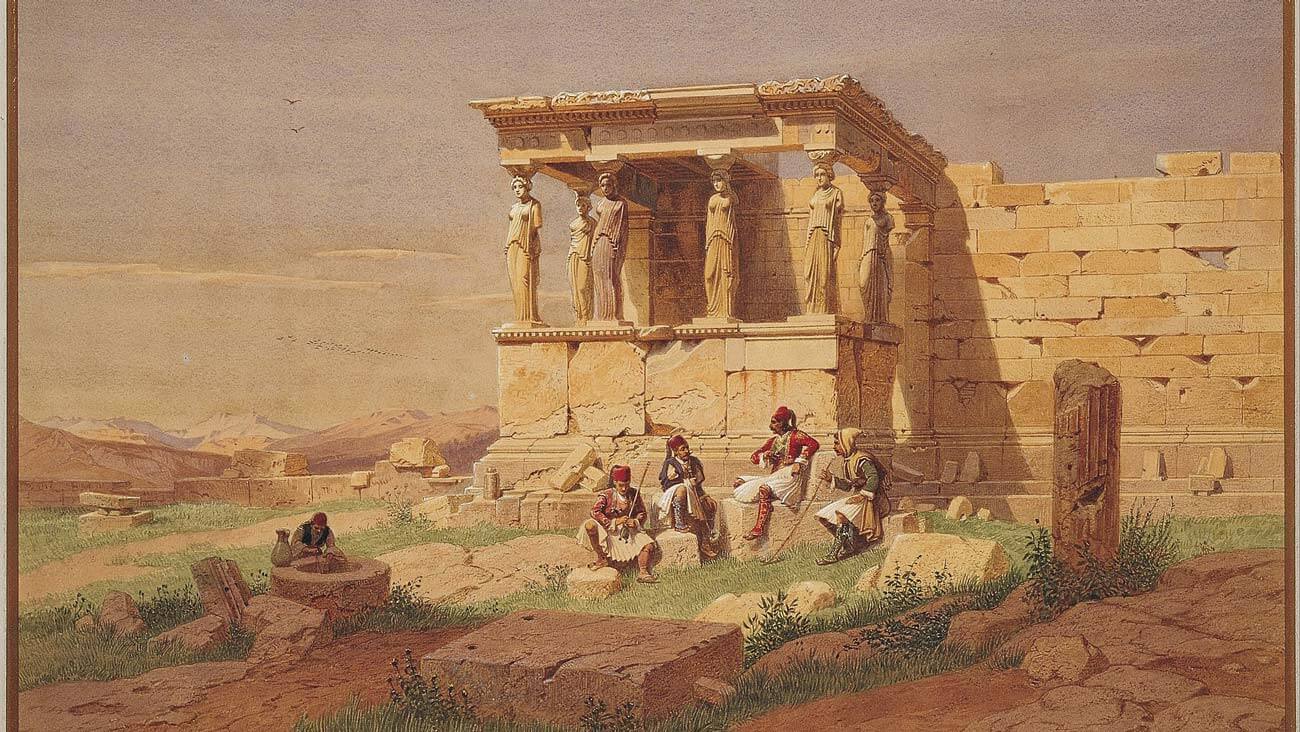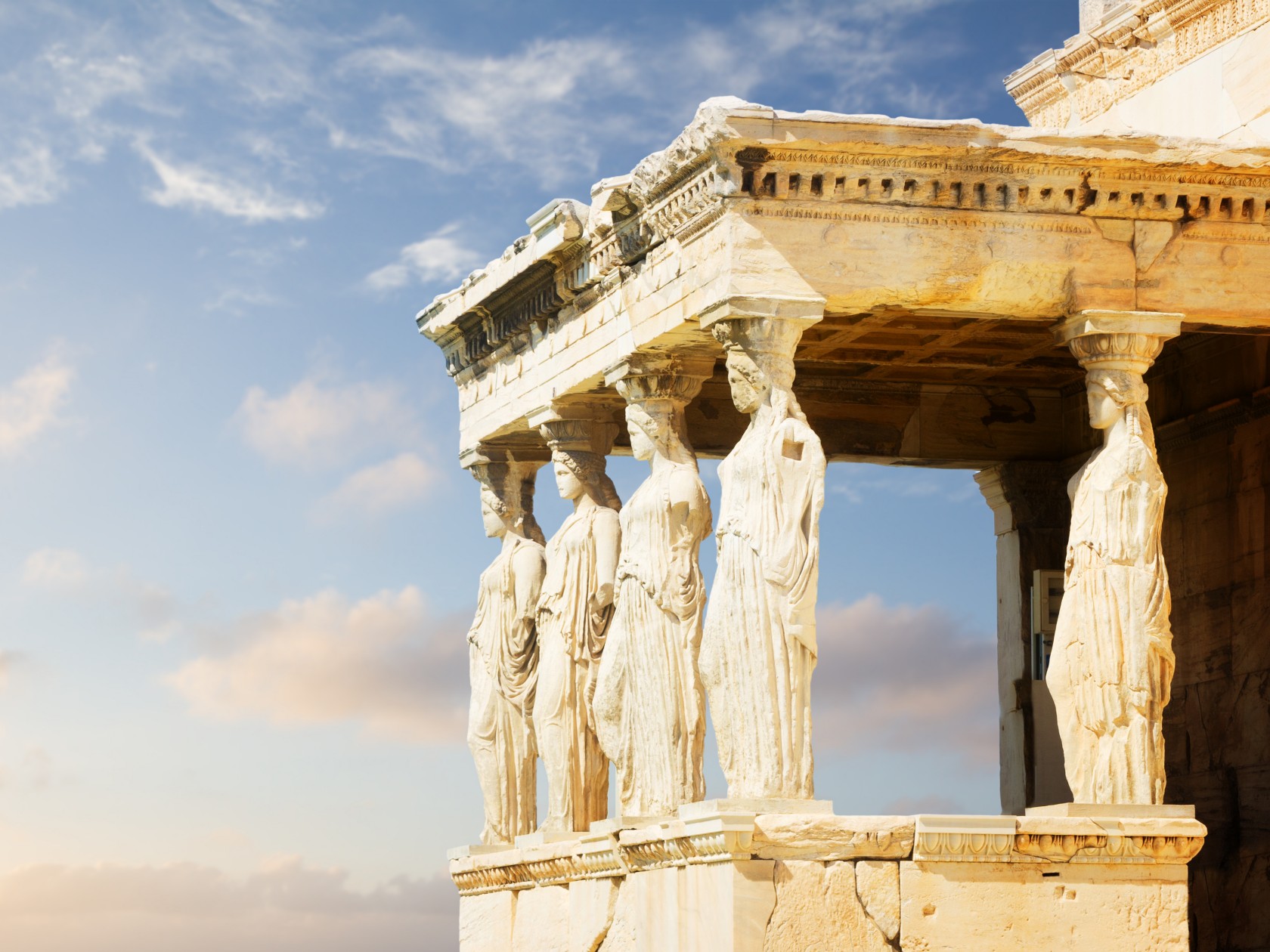The Erechtheion, situated on the Athenian Acropolis, is one of the most iconic structures from ancient Greece, celebrated for its unique architectural design and the renowned Caryatid Porch. Constructed between 421 and 406 BCE during the height of the Athenian Empire, the Erechtheion served as a temple dedicated to both Athena and Poseidon. While today the temple is primarily admired for its bare marble form, in its original state, the Erechtheion was a vibrant testament to the artistry of Greek architecture, adorned with bright colors that were characteristic of many temples of the time.

Original Paintwork c. 5th Century BCE
In antiquity, the Erechtheion would have presented a far more colorful spectacle than its weathered, white appearance today. Archaeological evidence and analysis suggest that vivid colors like reds, blues, and golds were employed to decorate its intricate architectural details. The friezes, columns, and Caryatids (sculpted female figures serving as columns) would have featured painted embellishments, enhancing their lifelike qualities and religious significance.

Key Features with Original Paintwork
- Frieze and Mouldings:
The sculpted frieze on the Erechtheion would have been richly painted, likely with alternating bands of vibrant reds and blues. This colorful scheme would have enhanced the sculpted reliefs, creating a striking contrast that stone alone could not achieve. Such vivid decoration would not only have drawn the eye but also emphasized the narratives depicted in the friezes, contributing to their storytelling function. - Caryatids:
The famous Caryatids, now appearing as pale stone statues, were likely adorned with painted garments in shades of blue, green, or yellow. Their elaborate hairstyles may have been accented with gold leaf, adding depth and dimension to their appearance. This attention to detail would have made them appear more lifelike and integral to the temple’s aesthetic. The Caryatids served not only as structural supports but also as powerful symbols of female divinity, enhanced by their colorful presentation. - Roof Decorations:
Ornamental elements on the roof, such as antefixes and acroteria (decorative roof statues), would have displayed intricate patterns and colors that contrasted vividly with the stone background. These embellishments would have added to the overall grandeur of the structure, enhancing its prominence on the Acropolis. Such roof decorations were essential for drawing the gaze upwards, inviting admiration for both the architecture and the deities it honored.
Preservation and Current State
The original paintwork of the Erechtheion, like many ancient Greek structures, has largely faded over time due to environmental exposure. Today, only traces of the original colors can be detected through microscopic analysis, providing valuable insights into the temple’s former splendor. While the marble structure commands admiration, recognizing its originally vibrant appearance adds depth to our understanding of ancient Greek artistry. The loss of color, although unfortunate, allows for the preservation of the intricate carvings and architectural forms that define the Erechtheion’s silhouette.

A Modern Comparison
Comparing the Erechtheion as it appears today to its potential appearance in the 5th century BCE allows us to appreciate the full splendor of ancient Greek architecture. Modern reconstructions and digital models attempt to visualize this contrast, vividly illustrating the detailed craftsmanship that once adorned the Athenian Acropolis. These visualizations help the public and scholars alike to grasp the aesthetic intentions of the architects and artists of the time, bridging the gap between past and present.

Conclusion
In summary, the Erechtheion was originally a much more vibrant and colorful structure than its present-day appearance suggests. The detailed carvings, statues, and architectural features were all richly painted to emphasize their religious and cultural significance, reflecting the grandeur of Athens during the classical period. The Erechtheion stands as a testament to the artistic legacy of ancient Greece, reminding us of a time when color and craftsmanship combined to create a truly magnificent temple. Through continued study and exploration, we can further uncover the layers of history embedded in this remarkable structure, appreciating its role as a cultural and architectural beacon of its time.

